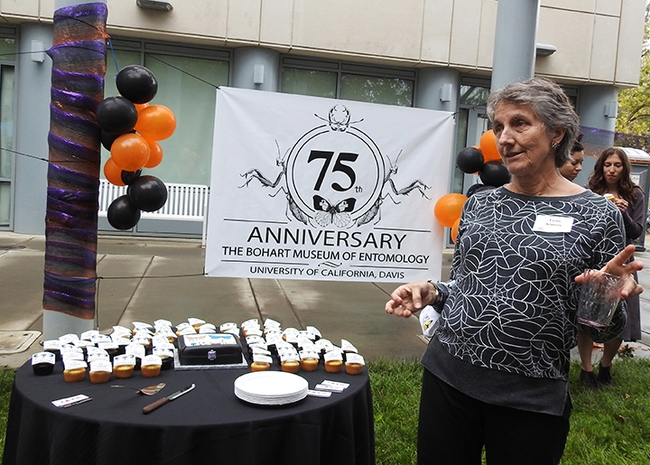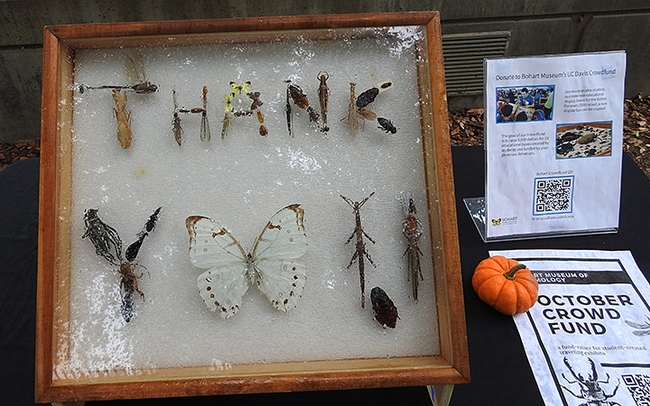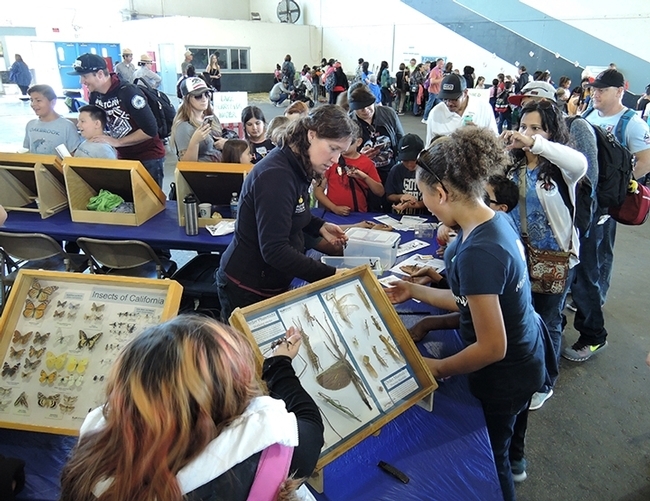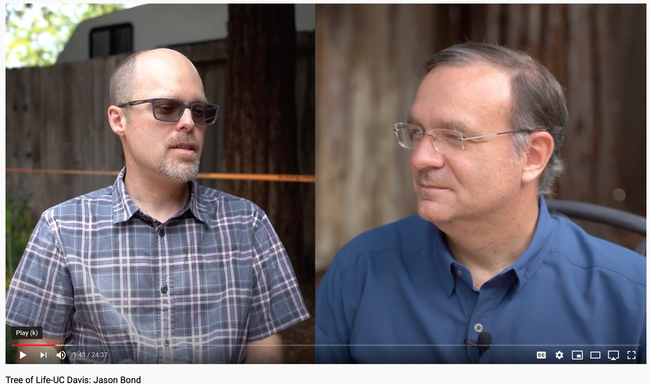- Author: Kathy Keatley Garvey
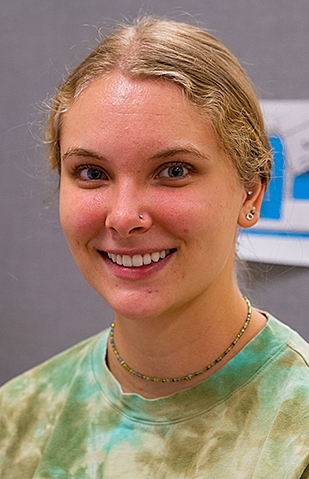
Annie is a pet scorpion belonging to Emma Jochim, a second-year doctoral student n the Jason Bond lab, UC Davis Department of Entomology and Nematology.
"She's an Anuroctonus pococki so I call her 'Annie' for short!" said Jochim. "The common name is 'Californian swollen stinger scorpion' because they have an extra 'bulb' on their telson that most scorpions don't, so I think that's pretty neat about this species. I haven't tried to handle her because she seems pretty aggressive--stinging crickets/roaches as soon as I put them in front of her and attacking water when I pour some in her enclosure."
Jochim's labmate, Xavier Zahnle, found the scorpion while he was collecting millipedes "and brought her back to me so I'm not sure how old she is but I've had her for a year and a half."
Emma holds a bachelor's degree in biology, with a minor in geology and chemistry, from Millsaps College, Jackson, Miss., where she graduated summa cum laude. Her honors thesis: "Species Delimitation of Vaejovis Scorpions from the Santa Catalina Mountains Using Genetic, Morphological, and Geographical Data." While a student at Millsaps College, her outreach activities including sharing her knowledge of tarantulas, scorpions and vinegaroons at the Mississippi Museum of Natural Science.
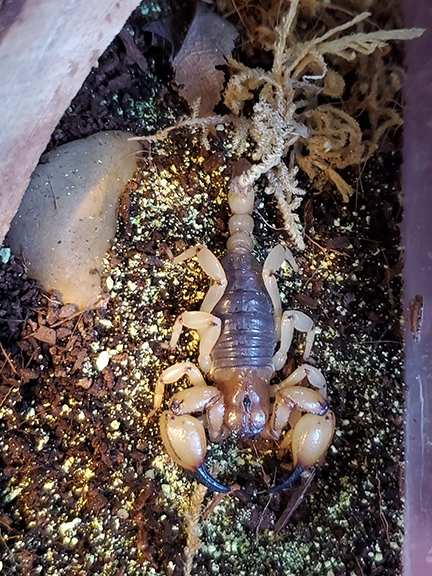
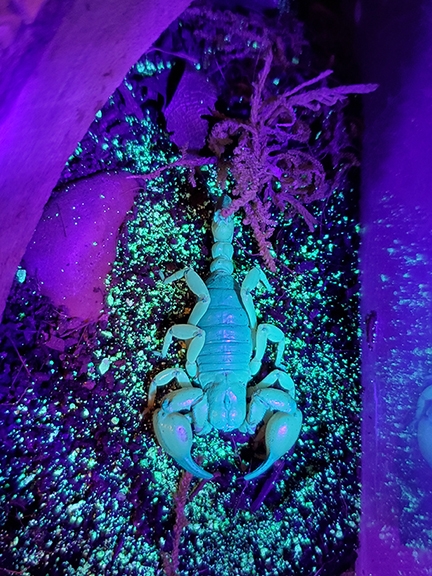
"Annie" will be just one of the live animals displayed in the Bohart Museum of Entomology/Jason Bond booth in the Conference Center. The Bond section also will include a live trapdoor spider (genus Hebestatis), a tarantula and millipedes, as well as specimens.
Doctoral candidate Lacie Newton of the Bond lab is coordinating the arachnid/myriapod section. Jason Bond, her major professor, is the Evert and Marion Schlinger Endowed Chair in Insect Systematics, UC Davis Department of Entomology and Nematology, and associate dean, College of Agricultural and Environmental Sciences.
"And there will be a small interactive station where people will be able to use props that mimic an insect flying into a web and learn more about the sensory structures that spiders have to detect those vibrations," Newton said.
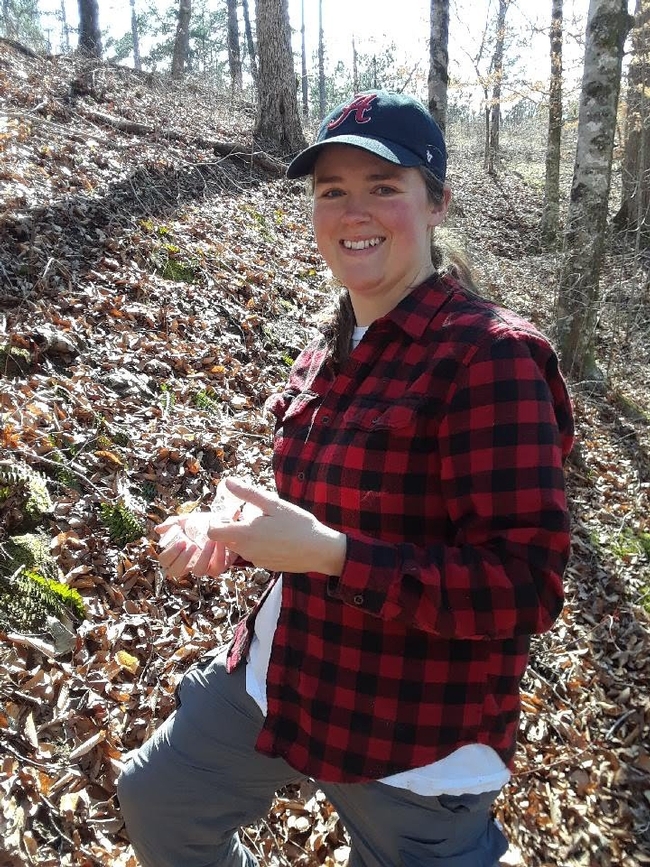
Eleven Museums, Collections. Scientists from a total of 11 museums or collections will staff booths in the Conference Center. Represented will be the Arboretum and Public Garden, UC Davis Bee Haven, Bohart Museum of Entomology, Botanical Conservatory, California Raptor Center, Center for Plant Diversity, Department of Anthropology Museum, Museum of Wildlife and Fish Biology, Nematode Collection, Paleontology Collection, and the Phaff Yeast Culture Collection. Visitors can sign up at the Conference Center for tours of several of the museums or collections. (See news story)
The UC Davis Biodiversity Museum Day is traditionally held on the Saturday of Presidents' Day weekend. However, last year's event was virtual, and this year's event is centrally located in an exposition. For more information, access the UC Davis Biodiversity Museum Day website and/or connect with Instagram,Twitter, and Facebook.
Bohart Fact Sheets on Scorpions. Lynn Kimsey, director of the Bohart Museum and UC Davis distinguished professor of entomology, has published two Fact Sheets about scorpions on the Bohart website.
Scorpions are arachnids, Kimsey writes, "and like all arachnids, they have eight legs, although it looks like ten, and a body divided into two regions, the cephalothorax (the head plus thorax) and the abdomen...The scorpion exoskeleton is different from that of similar groups. Something about it causes scorpions to fluoresce bright blue to green under ultraviolet light. So in the desert its easy to find them at night with a black light."
Kimsey describes scorpions as "nocturnal predators. During the day they hide under stones, logs or boards, or in cracks and holes in the ground. They prey on ground-dwelling insects and other small animals. Scorpions will occasionally wander into homes, particularly in new housing developments. New housing developments often encroach upon the scorpions' normal habitat and as a result these animals will blunder into homes searching for prey and shelter. Within several years, scorpions will no longer live in these areas because of the lack of suitable habitat and prey."
"The majority of California scorpion species average about 2 inches long as adults, however, some exotic species can be as long as 6 inches. Scorpions occur throughout the milder parts of California, including the Sierra foothills and the coastal mountains. Most of the species of scorpions in California pose no more threat to humans than do ordinary bees and wasps."
How long do they live? "Adult scorpions generally live two to three years," Kimsey relates. "They do not begin producing young until they are nearly a year old. Females produce between 20 and 30 live young at a time. Young scorpions are carried on the female's back for the first 5-15 days of life."
Read the two scorpion posts on the Bohart Museum website: one on scorpions in general and the other on sun scorpions. Sun scorpions, or solfugids, are distantly related to both scorpions and spiders.
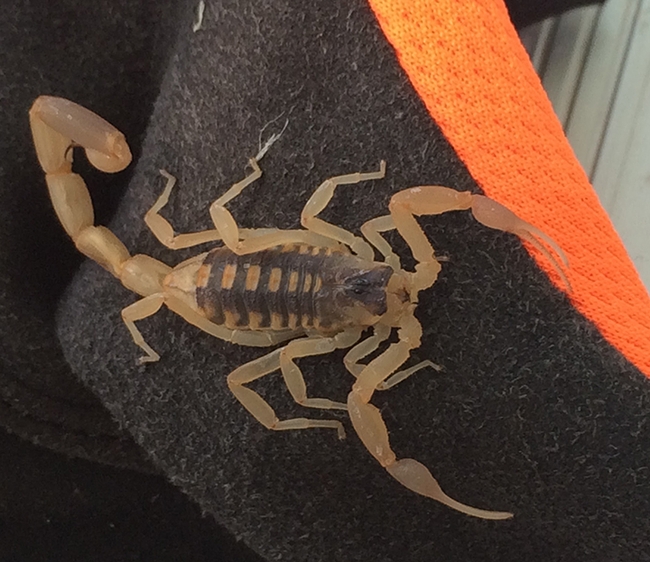
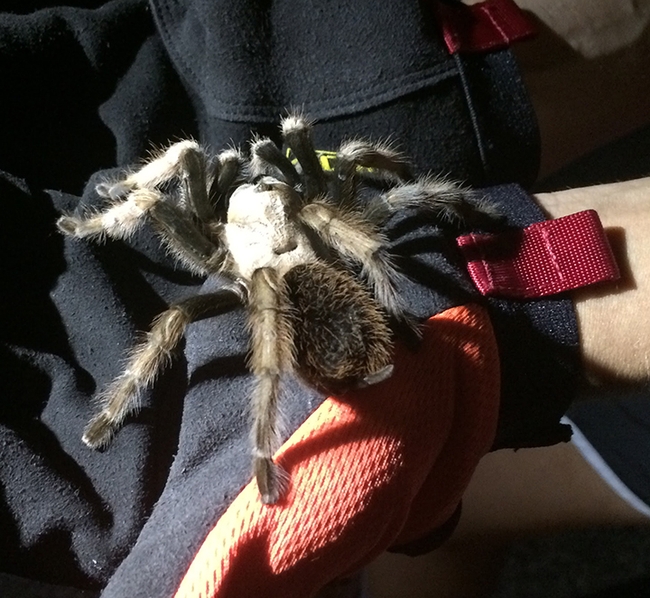
- Author: Kathy Keatley Garvey
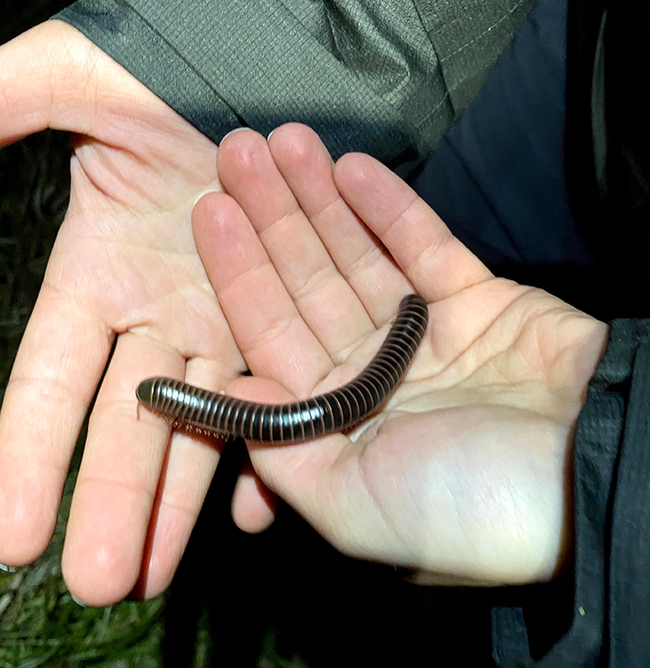
The science-based event, free and open to the public, is set for 11 a.m. to 3 p.m., Sunday, March 6 in the UC Davis Conference Center, 555 Alumni Lane.
This year the Biodiversity Museum Day is geared toward the UC Davis community, particularly undergraduates, said Biodiversity Museum Day co-organizer Tabatha Yang, education and public outreach coordinator for the Bohart Museum of Entomology. Admission and parking are free, but visitors must adhere to the COVID-19 Campus Ready guidelines. Masks will be required in accordance with campus policies. (See news story)
Sharing the Bohart Museum booth in the Conference Center will be the Jason Bond laboratory. Bond is the Evert and Marion Schlinger Endowed Chair in Insect Systematics, UC Davis Department of Entomology and Nematology, and associate dean, College of Agricultural and Environmental Sciences.
"The arachnid/myriapod section of Biodiversity Museum Day will consist of some live specimens--a tarantula, trapdoor spider, scorpion, and some millipedes, and ethanol preserved specimens of arachnids/myriapods that are pretty common and/or well-known, and a small interactive station where people will be able to use props that mimic an insect flying into a web and learn more about the sensory structures that spiders have to detect those vibration," said doctoral candidate Lacie Newton of the Bond lab, coordinator of the exhibit.
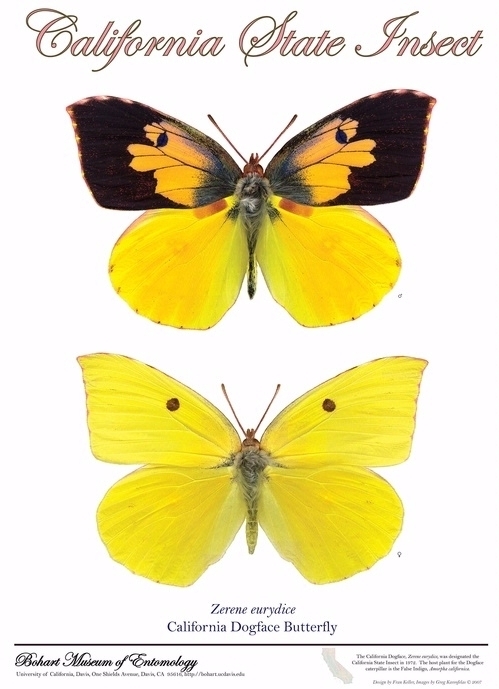
Visitors to the Conference Center will see displays from 11 museums or collections on campus:
- Arboretum and Public Garden
- UC Davis Bee Haven
- Bohart Museum of Entomology
- Botanical Conservatory
- California Raptor Center
- Center for Plant Diversity
- Department of Anthropology Museum
- Museum of Wildlife and Fish Biology
- Nematode Collection
- Paleontology Collection
- Phaff Yeast Culture Collection
Visitors can sign up at the Conference Center for special tours:
- The Bohart Museum of Entomology, located in Room 1124 of the Academic Surge Building, Crocker Lane, has scheduled tours at noon, 1 and 2. The Bohart houses a global collection of eight million insect specimens, and also a live "petting zoo" and gift shop. "People will sign up at the Convention Center and be chaperoned over approximately 15 minutes before the hour to the attend their tour," said Tabatha Yang, education and outreach coordinator. "Tours should last 30 to 45 minutes." Entomologist Jeff Smith, curator of the Lepidoptera collection, will be discussing butterflies and moths.
- The UC Davis Bee Haven, located on Bee Biology Road, next to the Harry H.Laidlaw Jr. Honey Bee Research Facility, west of the central campus, will offer tours at noon and 2. Established in the fall of 2009, the Bee Haven is a half-acre demonstration garden operated by the Department of Entomology and Nematology. "We'll focus on how best to observe and identify bees in the garden, as well as suggested bee plants that grow well in our area with low water," said Christine Casey, academic program management officer of the Bee Haven.
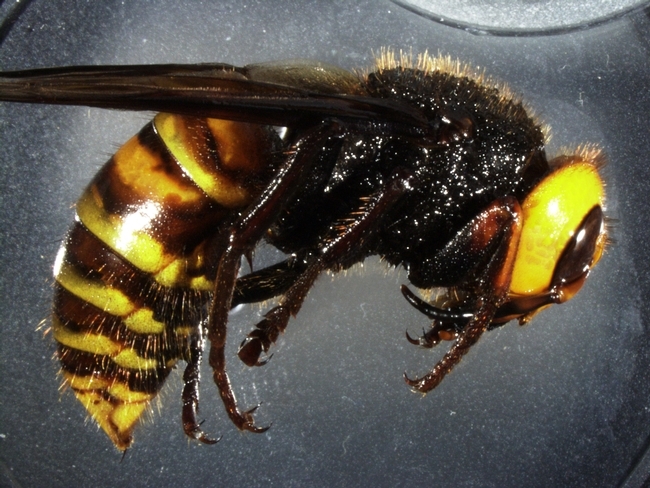 An Asian giant hornet from Blaine, Wash. This insect, nicknamed "murder hornet," will be discussed at the UC Davis Biodiversity Museum Day. (Photo by Allan Smith-Pardo, USDA)
An Asian giant hornet from Blaine, Wash. This insect, nicknamed "murder hornet," will be discussed at the UC Davis Biodiversity Museum Day. (Photo by Allan Smith-Pardo, USDA) - The Arboretum and Public Garden will provide two 30-45 minute tours, "Climate-Ready Tree Project: Texas Tree Trials." Groups will leave the Conference Center at 11:30 a.m. and 1:30 p.m. The project mission is to see if trees from west and central Texas will do well in this climate. The project involved collecting seeds, propagating them and planting them in the Arboretum.
- The Phaff Yeast Culture Collection is planning self-guided tours of the UC Davis Brewery, used for teaching and research, according to Kyria Boundy-Mills, curator, Phaff Yeast Culture Collection, Food Science and Technology.
Different yeast strains are used for different styles of beer. These include ale yeast strains, lager yeast strains, and Belgian beer strains that are hybrids of wild yeasts. UC Davis offers an undergraduate major in food science and technology, with an emphasis on brewing science. Training includes chemistry, biochemistry, microbiology, quality assurance, engineering, sanitation, packaging, malting and crewing. The program currently includes 18 students studying for their bachelor of science degrees, and three students seeking their master of science degrees. - The Botanical Conservatory is technically not offering tours, says manager Ernesto Sandoval "but we will be open to the public so people can wander through at their own pace and we'll regulate the number of people in the greenhouse at any one time. They can see our revamped succulent and carnivore rooms as well as our Cacao, aka 'Chocolate Tree,' with fruits as well as coffee and a very happy vanilla plant all amongst an incredible diversity of plants from ferns to an assortment of orchids."
The UC Davis Biodiversity Museum Day is traditionally held on the Saturday of Presidents' Day weekend. However, last year's event was virtual, and this year's event is centrally located. For more information, access the UC Davis Biodiversity Museum Day website and/or connect with Instagram,Twitter, and Facebook.
Another upcoming event is the 108th annual UC Davis Picnic Day, a campuswide open house scheduled April 23.
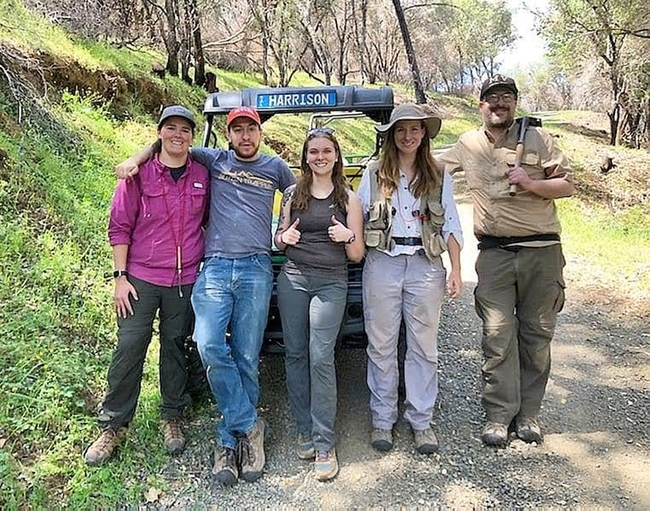
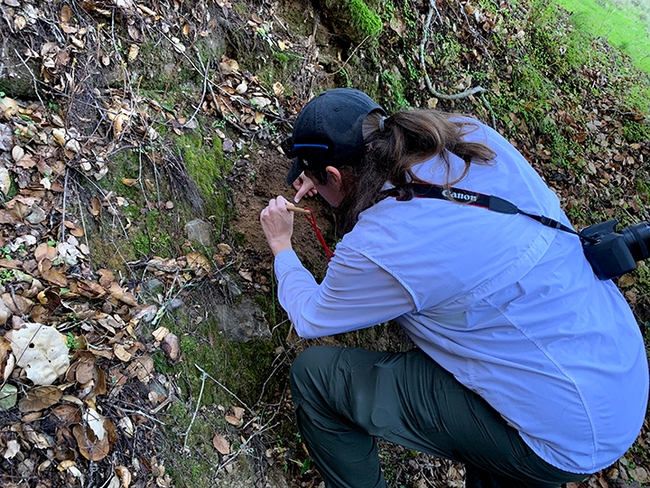
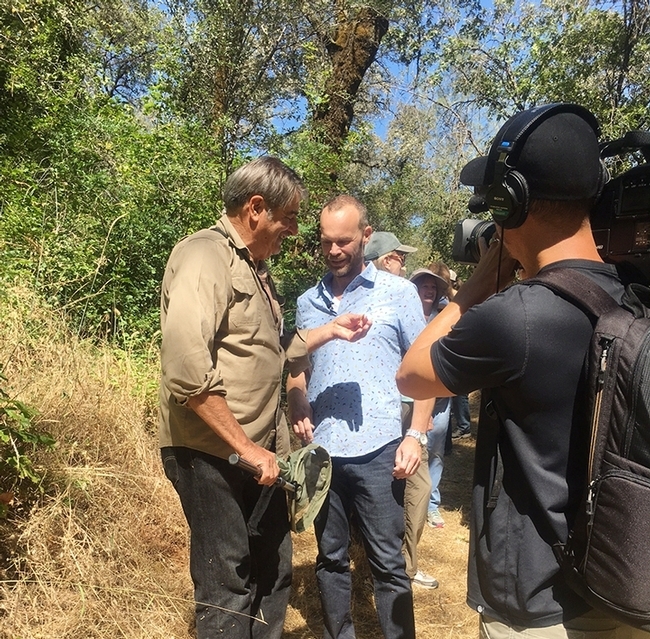
- Author: Kathy Keatley Garvey
If you dislike spiders, you might want to check out the political scene (probably not!), the almond pollination season (yes, it's coming), or ask Siri "When does spring begin? (Answer: March 20)
Wait, are you still there? Whew! Then you'll want to know about the upcoming gathering of arachnologists--those who engage in the scientific study of arachnids, including spiders, scorpions and tarantulas.
News flash: The University of California, Davis, will be the site of the 2022 American Arachnological Society (AAS) convention. It's set from Sunday, June 26 through Thursday, June 30.
It will be hosted by two UC Davis arachnologists: Jason Bond, the Evert and Marion Schlinger Endowed Chair in Insect Systematics, UC Davis Department of Entomology and Nematology, and associate dean, College of Agricultural and Environmental Sciences; and Joel Ledford, assistant professor of teaching, Department of Plant Biology, College of Biological Sciences.
Formal meeting registration will begin Sunday afternoon, June 26, followed by an evening reception. A local daylong field trip is planned for Thursday, June 30. (Pre-register for the meeting at https://ces.ucdavis.edu/AASM)
"We typically expect somewhere around 125-150," Bond says.
The event is sponsored by the U.S. National Science Foundation. In collaboration with the UC Davis Bohart Museum of Entomology and the University of Nebraska, “we will also host a pre-meeting, outreach event, ‘Eight-Legged Encounters' for the Davis community and campus,” Bond said. It's tentatively planned for Saturday, June 25. Those interested in attending should contact Bond at jbond@ucdavis.edu.
The purpose of the American Arachnological Society, founded in 1972, is “to further the study of arachnids, foster closer cooperation and understanding between amateur and professional arachnologists, and to publish the Journal of Arachnology," according to its website.
Factoid from AAS: "Spiders (order Araneae) are air-breathing arthropods that have eight legs and chelicerae with fangs able to inject venom. They are the largest order of arachnids and rank seventh in total species diversity among all orders of organisms. Spiders are found worldwide on every continent except for Antarctica, and have become established in nearly every habitat with the exceptions of air and sea colonization. As of March 2021, at least 49,200 spider species, and 129 families have been recorded by taxonomists. However, there has been dissension within the scientific community as to how all these families should be classified, as evidenced by the over 20 different classifications that have been proposed since 1900."
Also, check out the AAS frequently answered questions. Did you know you can ask a question?
Question: "Is it true that the black widow spider always eats her mate?"
Answer: "Nope. Black widow females are no more likely than any other female spider to eat their mates. If the female is ready to mate and if the male sings the right sweet silk song to her, then she will allow him to approach and to mate. If the female is not particularly hungry, she will likely allow the male to leave unscathed after copulation. However, the female black widow, as is common in spiders, is larger than the male. Thus, if she is hungry, she may feed on the male but this is true of many species of spiders."
Meanwhile, if you want to learn the basics about common spiders found in California, the UC Statewide Integrated Pest Management Program website offers information on black widow spiders, jumping spiders, common house spiders, and tarantulas, among others (including the hobo spider, which is not found in California). A table, illustrated with photos, lists the common spider families in North America, including:
- Agelenidae, funnel weavers or grass spiders
- Araneidae, orb weavers or garden spiders
- Clubionidae (including Corinnidae), sac spiders or twoclawed hunting spiders
- Linyphiidae (=Microphantidae), dwarf spiders
- Lycosidae, wolf spiders
- Oxyopidae, lynx spiders
- Salticidae, jumping spiders
- Theridiidae, cobweb, cobweb weaver, or combfooted spiders
- Thomisidae, crab spiders or flower spiders
If you're like me, you've probably seen--and admired--scores of spiders in your garden. Want to know who's coming to dinner? Here are images of some of my favorites:
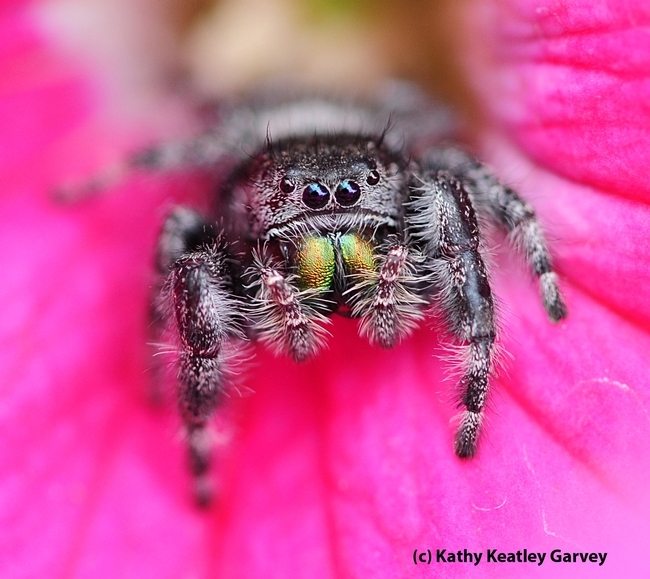
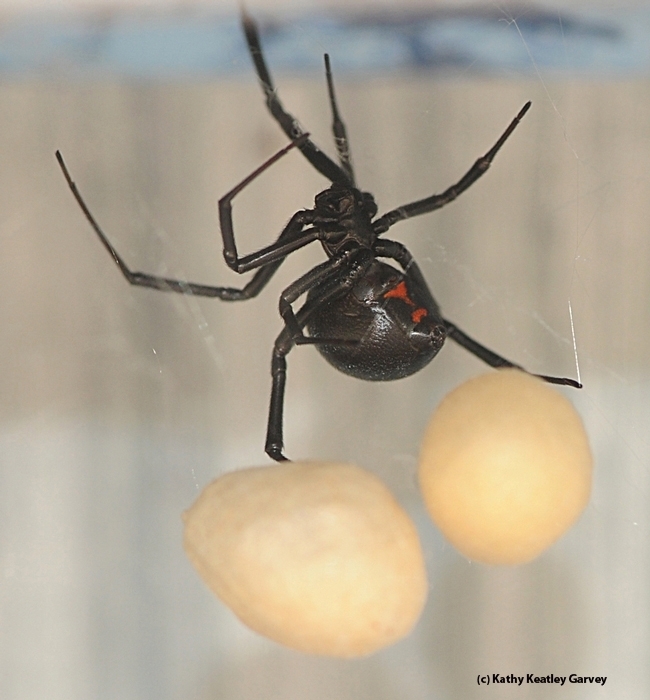
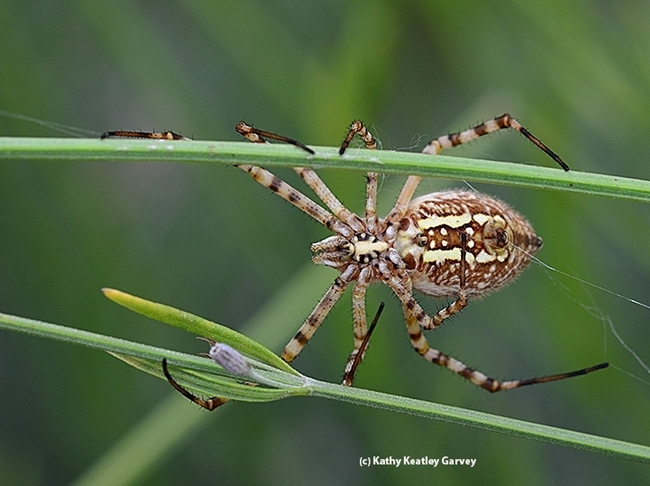
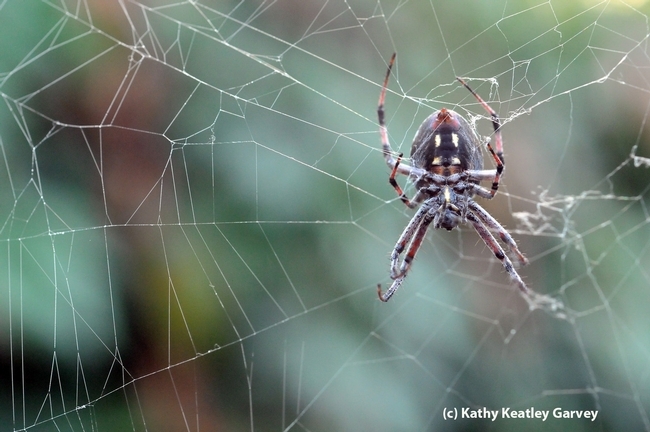
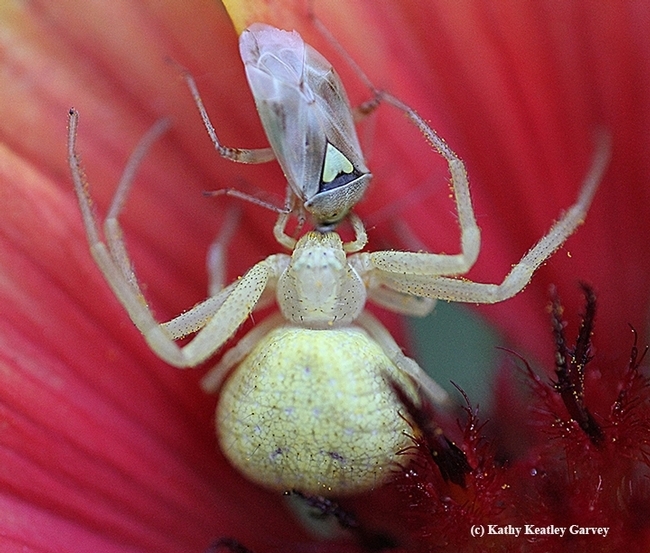
- Author: Kathy Keatley Garvey
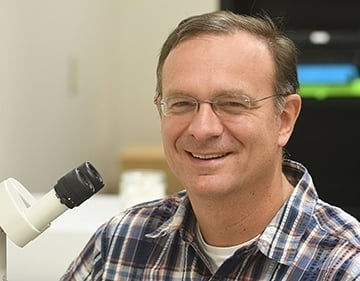
Some folks just despise spiders.
A Facebook post that went viral has resulted in USA Today setting the record straight today (Nov. 9) by conferring with UC Davis arachnologist Jason Bond. He's an expert on spiders; the Evert and Marion Schlinger Endowed Chair, UC Davis Department of Entomology and Nematology; and the newly appointed Associate Dean for Research and Outreach for Agricultural Sciences, UC Davis College of Agricultural and Environmental Sciences.
The "trouble" began Oct. 27 when a Facebook user in Nigeria posted several pictures (at 3:46 a.m., by the way!) of a gorgeous spider (well, I think it's gorgeous). She warned: "For those of you who are going to the beach. Please beware of this. Don't try to pick it up thinking it's a work of art. It's a very poisonous spider. If it stings you, you will die within five minutes."
As of today, the post drew 5,000 comments and 89,000 shares--and a new nickname for the spider: "Oreo spider." You know, the cookie?
Many expressed disbelief at the very start. Scolded one Facebook user in all caps: "THERE IS NO SPIDER BITE THAT I KNOW OF THAT WILL KILL YOU IN 5 MINUTES. TALK TO ME." (She apparently didn't.) Others found the text and images as terrifying as "murder hornets."
USA Today Fact Check disputed the post with: "Viral photos show trapdoor spider that isn't poisonous to humans."
The spider? It's in the genus Cyclocosmia and belongs to the family of cork-lid trapdoor spiders.
Bond told USA Today in a Nov. 5th telephone interview: “Nearly all spiders have venom, but very few of those are toxic to humans. Cyclocosmia is one of those spider groups that has no known toxicity to humans...Most people have never seen (them) because you really have to go out and look for them. They're not incredibly common, and then, of course, you'd have to dig one out of its burrow to even get bitten by it.”
“(In) all my years of collecting and working on trapdoor spiders, the only time any of us have ever gotten bitten by one was in the lab, when we were trying to photograph them,” Bond told USA Today. “For most spiders, you have to provoke them, you've got to grab them, you have to do something to make them really defensive to get them to bite you.”
He further said: "In that rare situation when a trapdoor spider bites, you might feel the pinch of tiny fangs, but you don't really feel anything from the venom.”
Nature photographer Nicky Bay, an incredible macro photographer, took the images of the cork-lid trapdoor spider in Thailand and posted them on his Flickr account in 2019. He clarified: "The cork-lid trapdoor spider has a highly sclerotised and abruptly truncated abdominal posterior, which is used as a plug to its burrow entrance. This prevents any effective attacks from predators such as wasps."
Apparently someone "found" his copyrighted images and "borrowed" them.
Bay subsequently tweeted that the Facebook post contains "a whole bunch of falsehoods."
So, bottom line:
- You won't find these spiders on the beach. It's safe to go to the beach. Bring your towel and your dog.
- Spiders don't sting; they bite. Bees sting.
- You will probably never encounter these cork-lid trapdoor spiders anywhere (much less on the beach), but if you do, you're not likely to pick them up, thinking "Wow! What an amazing piece of art." Who does that?
- The venom of these spiders is poisonous to their prey, including grasshoppers and crickets, as well as other small critters. You are not the prey.
- You won't perish from the bite. Why the "deadline" of five minutes? You got the spider on a five-minute timer or something?
Meanwhile, arachnologists around the world must be (1) shaking their heads in unison and in disbelief (2) laughing uproariously or snickering outlandishly or (3) wondering if they can create a "Oreo spider" costume for next Halloween.
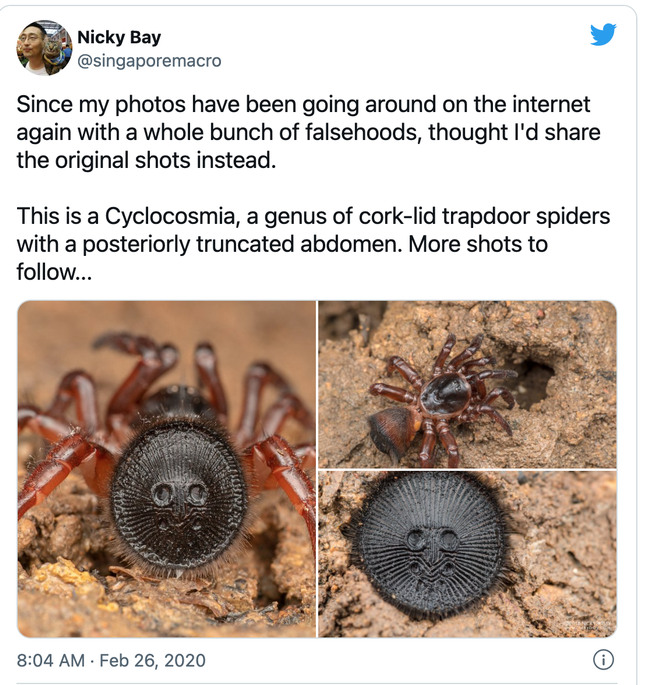
- Author: Kathy Keatley Garvey
The public will benefit from the Bohart Museum of Entomology's UC Davis Crowd Fund, a $5000 fundraising drive that ends at 11:59 a.m. on Sunday, Oct. 31.
With the funds, UC Davis students will create portable insect-specimen traveling boxes that make their way throughout Northern California to help folks learn about the exciting world of insect science, including bees, butterflies and beetles. The glass-topped boxes travel to school classrooms, youth group meetings (such as 4-H, Boy Scouts and Grange), festivals, libraries, fairs, special events, museums, hospitals--and more.
The Bohart Museum, which is celebrating its 75th anniversary this year, originated in 1946 when noted entomologist Richard M. Bohart (1913-2007), UC Davis professor of entomology, filled two Schmitt boxes with insect specimens. That was the beginning of the UC Davis insect museum. Named the Bohart Museum in 1982, it is now the home of nearly eight million insect specimens, collected worldwide
Lynn Kimsey, director of the Bohart and a UC Davis distinguished professor of entomology, drew praise last Saturday at the museum's 75h anniversary party, hosted by the Bohart Museum Society.
Emcee Jason Bond, the Evert and Marion Schlinger Endowed Chair and professor, UC Davis Department of Entomology and Nematology, and the newly named Associate Dean for Research and Outreach for Agricultural Sciences, UC Davis College of Agricultural and Environmental Sciences, urged the crowd to help support the outreach mission of the museum.
“Collections have a tremendous educational value,” Bond said, “and they also have amazing research value as well. Discoveries of new species don't actually happen in the field, they happen in the museum collections. New species on the average spend about 25 years on the shelf before a graduate student, undergraduate student or a researcher pulls them off shelf and describes or discovers them.”
He offered a toast to Kimsey, who in turn praised the thousands of collectors “who have their names” on the specimens. “We've been doing this for a long time. Eventually we'll be able to serve the public again like we should. Otherwise it would just be a dead collection in a building somewhere.”
Kimsey interviewed “Doc” Bohart, then 82, in 1996 as part of the Aggie Videos collection. (See https://bit.ly/2Zv8rvO.) Bohart, who began his UC Davis career in 1946, chaired the Department of Entomology from 1963 to 1967.
Unparalleled Research. “His scientific research on insect taxonomy and systematics is unparalleled,” Kimsey wrote on the Bohart website. “His publications include three of the most important books on the systematics of the Hymenoptera, including the well-used volume Sphecid Wasps of the World. His journal publications total over 200 articles. He revised many groups of insects, discovered new host-associations or geographic ranges, and described many new species."
Kimsey, an alumnus of UC Davis, received her undergraduate degree in 1975 and doctorate in 1979. She joined the UC Davis faculty in 1989. A two-term president of the International Hymenopterists, and a recognized global authority on the systematics, biogeography and biology of the wasp families, Tiphiidae and Chrysididae, she won the 2020 C. W. Woodworth Award, the highest award given by the Pacific Branch of the Entomological Society of America, for "her 31 years of outstanding accomplishments in research, teaching, education, outreach and public service."
The need to update and expand the Bohart Museum's traveling display is urgent, the scientists said.
“We have all these bright, students on campus with fresh and diverse perspectives," commented Tabatha Yang, the Bohart Museum's education and outreach coordinator. "We want to support their talent, so the funds we are raising will go to students for the creation of new traveling displays. This fleet of new educational drawers will expand and update what we can offer. Some of our current displays were created 15 years ago! One can only imagine all the places these drawers have been and all the people who have been inspired."
Donors can do so in memory of someone, a place, or a favorite insect. Bond donated $500 in honor of Lynn Kimsey, and Lynn Kimsey donated $500 in memory of the founder, Richard M. Bohart. The donation page, which includes a U.S. map of where the donors reside, is at https://bit.ly/3v4MoaJ
The Bohart Museum, currently closed to the public due to COVID-19 precautions, is located in Room 1124 of the Academic Surge Building on Crocker Lane, UC Davis campus. In addition to its insect collection, which is the seventh largest in North America, the museum houses a live “petting zoo,” comprised of Madagascar hissing cockroaches, stick insects and tarantulas, and a gift shop (now online), stocked with insect-themed t-shirts, hoodies, jewelry, books, posters and other items. Further information is on the website at https://bohart.ucdavis.edu.
